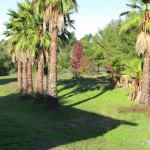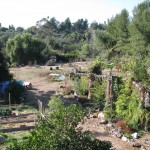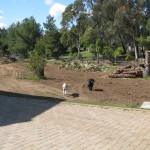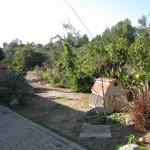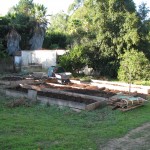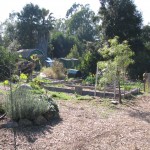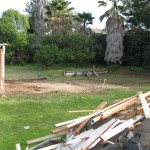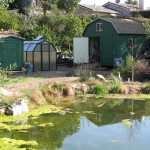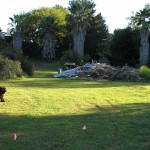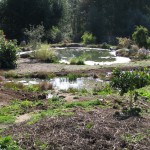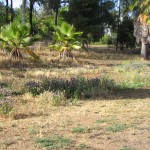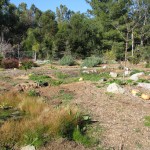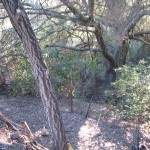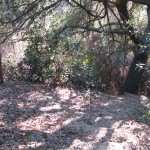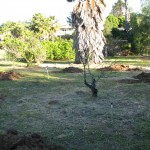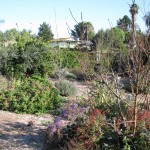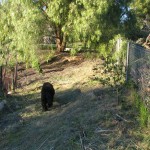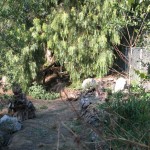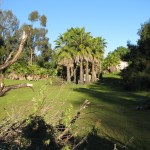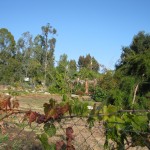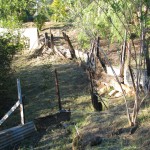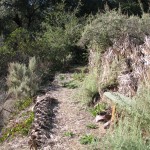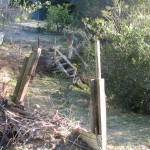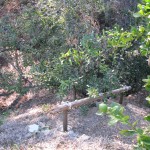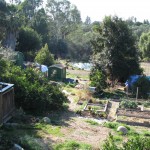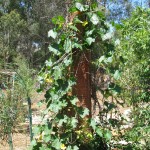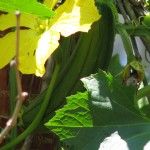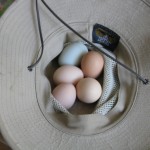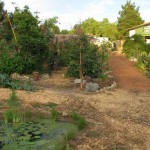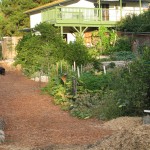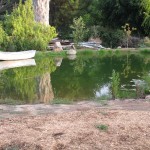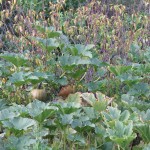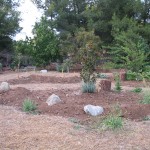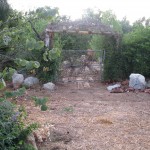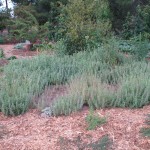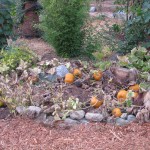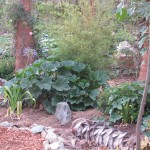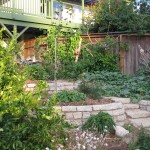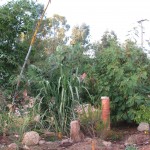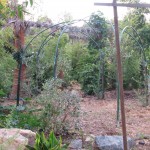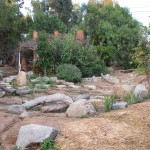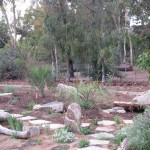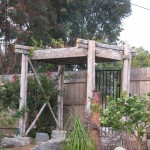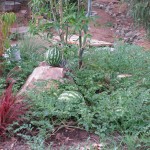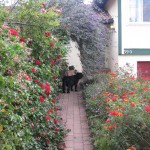- Animals, Bees, Birding, Building and Landscaping, Chickens, Cob, Compost, Composting toilet, Fungus and Mushrooms, Gardening adventures, Giving, Health, Heirloom Plants, Hiking, Houses, Hugelkultur, Humor, Living structures, Natives, Natural cleaners, Other Insects, Permaculture and Edible Forest Gardening Adventures, Pets, Photos, Predators, Quail, Rain Catching, Recycling and Repurposing, Reptiles and Amphibians, Seeds, Soil, Vegetables, Water Saving, Worms
Special Tours for Aug. and Sept., 2014
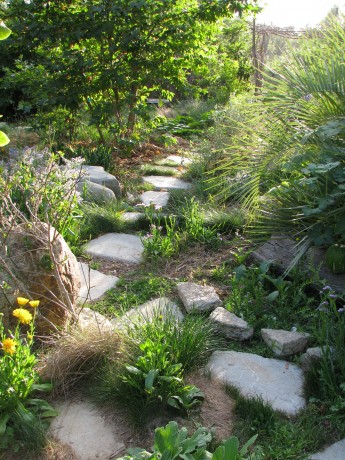
Come take a tour of a food forest! Normally tours of Finch Frolic Garden are held by appointment for groups of 5 – 15 people, Thursdays – Mondays. Cost is $10 per person and the tour lasts about two hours. By popular demand, for those who don’t have a group of five or more, we will be hosting Open Tour days for the first 15 people to sign up in August and September. They will be Sunday, August 10 and 24, Sept. 7 and 21, and Thursdays August 7 and 28, and Sept. 11 and 25. Tours begin promptly at 10 am. The tours last about two hours and are classes on basic permaculture while we tour the food forest. I ask $10 per person. Please reserve and receive directions through dianeckennedy@prodigy.net. Children under 10 are free; please, no pets. Photos but no video are allowed. Thank you for coming to visit! Diane and Miranda
- Animals, Bees, Birding, Books, Building and Landscaping, Chickens, Cob, Compost, Composting toilet, Fungus and Mushrooms, Gardening adventures, Heirloom Plants, Hugelkultur, Humor, Living structures, Natives, Natural cleaners, Other Insects, Permaculture and Edible Forest Gardening Adventures, Ponds, Predators, Quail, Rain Catching, Recycling and Repurposing, Reptiles and Amphibians, Seeds, Soil, Water Saving, Worms
Permaculture Lectures At Finch Frolic Garden, June 2014
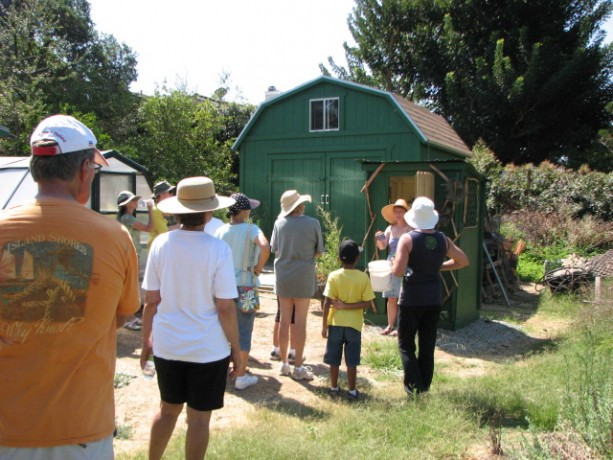
Tour Finch Frolic Garden! Permaculture Lectures in the Garden!
Learn how to work with nature and save money too
Finch Frolic Garden and Hatch Aquatics will present four fantastic, information-filled lectures in June. Join us at beautiful Finch Frolic Garden in Fallbrook, 4 pm to 6 pm, for refreshments and talks on…
Saturday, June 7: Introduction to Permaculture and Finch Frolic Tour: We’ll take you through the main precepts of permaculture and how it can be applied not only to your garden, but to yourself and your community. Then we’ll tour Finch Frolic Garden and show rain catchments, swales, plant guilds, polyculture, living buildings and so much more.
Saturday, June 14: Your Workers in the Soil and Earthworks: Learn the best methods for storing water in the soil and how to replace all your chemicals with actively aerated compost tea and compost.
Saturday, June 21: Aquaculture: You can have a natural pond – even in a tub! How natural ponds work, which plants clean water and which are good to eat. Even if you don’t want a pond, you’ll learn exciting information about bioremediation and riparian habitat.
Saturday, June 28: Wildlife in your Garden: What are all those bugs and critters and what they are doing in your yard? We’ll discuss how to live with wildlife and the best ways to attract beneficial species.
Your hosts and lecturers will be
Jacob Hatch Owner of Hatch Aquatics. With years of installing and maintaining natural ponds and waterways, and a Permaculture Design Course graduate, Jacob has installed earthworks with some of the biggest names in permaculture.
Miranda Kennedy OSU graduate of Wildlife Conservation and wildlife consultant, Miranda photographs and identifies flora and fauna and maps their roles in backyard ecosystems.
Diane Kennedy Owner of Finch Frolic Garden, lecturer, consultant, Permaculture Design Course graduate, former SDC Senior Park Ranger, Diane educates homeowners on how to save money and the environment while building their dream gardens.
Each class limit is 50 attendees, so please make pre-paid reservations soon before they fill up. Fee for set of four lectures and tour is $45 per person. Single session fee is $20 per person. Contact Diane Kennedy at dianeckennedy@prodigy.net for reservations and directions.
You will not want to miss this fascinating and useful information!
- Animals, Bees, Birding, Chickens, Gardening adventures, Heirloom Plants, Other Insects, Permaculture and Edible Forest Gardening Adventures, Photos, Ponds, Rain Catching, Vegan, Vegetables, Vegetarian
Garden’s One Year Anniversary
Happy Anniversary! One year ago on Feb. 1, 2011, I signed a contract with landscape architect Roger Boddaert (760-728-4297) to create a permaculture garden. For twelve years I’ve had this sloping property that was covered in weeds and worthless Washingtonia palms. Not only do these 2 acres slope down to a barranca, but it was filled in due to catching all the rainwater that runs from the street and properties above. I have to give credit to friend Gary B., who brought up the subject of permaculture in a conversation the year before. I’d heard the term and thought I knew what it was about, but months later when I was researching what to do with my property I remembered him mentioning it, and looked it up. I found what I was looking for. I’ve been an organic gardener for many years, have owned chickens for their eggs, have refused to till the soil so as not to kill microbes, have worked naturally with animals and plants, have created habitat, composted, recycled, collected rainwater… and all of that was permaculture. And so much more. How can one not be attracted to the term Food Forest? Certainly not a foodie and gardener like myself.
What happened on the property starting the week of Feb. 1 for the next six months altered the land so that it is truly two acres of habitat. It is useful, it is natural, and it is beautiful. Roger’s team led by Juan built beautiful walls of urbanite, planted and hauled, worked in scorching sun and frosty mornings and made what was dreamed into reality. An integral part of the garden has been diverting the water from erosion points and into rain catchment basins and natural ponds, and that is where Aart DeVos and Jacob Hatch of Aquascape (760-917-7457) came in. They also installed the irrigation. Dan Barnes did the rough and the precise tractor work (760-731-0985) and I can’t recommend his experience and skill enough. Fain Drilling dug the well (760-522-7419) and the wonderful sheds were built by Quality Sheds of Menifee (http://www.socalsheds.com) .
Along with some volunteer help from Jacob, I am the sole caretaker of the property. I am planning the plant guilds, weeding, improving soil, moving problem plants and trees and, did I mention, weed? Oh yes, then there is weeding. On Saturday May 12th, the garden will be on the Garden Tour of the Association of University Women of Fallbrook, and hopefully many people will be inspired to go organic, to create habitat, conserve water and grow extra food for the Fallbrook Food Pantry. We’ve come a long way, baby!
The following photos are comparisons between the precise location last year at this time, and today.
The property last February. The property today. Sophie and General loved all the excitement. They love the new gardens and pond even more. My veggie beds with the old sheds behind. My veggie beds with the new sheds and greenhouse behind. Where the big sheds were: everything usable was reused. New sheds that aren’t a safety hazard, and the greenhouse. The lower area with shed debris (lots of mowing area!). Hey, there are ponds there now! Not much for the neighbors to look at. Quite a lot for the neighbors to look at! Access to the old oak was hazardous. Palm stairs lead past the oak to a birding area. Stonefruit were old when I moved in. New stonefruit adorn what is now the Bee Garden. An erosion area sloping down to the barranca. Water won’t flow through here anymore. Lots of mowing and palm frond removal. Not so anymore. Horrible looking debris failed to hold back the embankment. Palms were used to stabilize the new paths and camoflage the supports. Old unstable stairs led to washout areas. New railings, stairs and urbanite retaining walls lead to another viewing area. The view from my balcony. Part of the old shed remains. Hey, there’s a pond there! -
First Rain
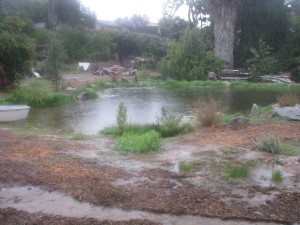
Rainfall on the pond The first week of October and we’re having a day of heavy rain… almost unbelievable. Normally October in San Diego is high fire season. The brush is crisp from months of drought and high temperatures, and then the Santa Ana winds begin: wild dry winds that blow east to west from the deserts, full of static and mad gusts that turn brush fires into firestorms.
My property is a watershed, funneling rainwater from the street through to the streambed in the barranca below, taking all my topsoil and some of the embankment with it. This year I had the beginnings of a permaculture garden installed to remedy this pattern. By deepening the loam and placing berms around plant guilds water is encouraged to pool up and soak in rather than run off. Overflow is channeled through a series of dry ponds which allow water to soak into the ground. From there it is channeled safely down to an overflow into the stream. Today was an early test of what has been worked on since Feb. 1.
The tilling, mulching and berming done by the crew of landscape architect Roger Boddaert proved successful.
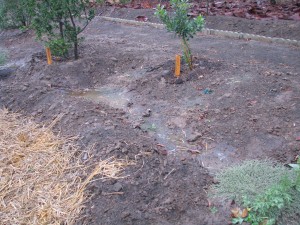
Berms hold water back so that it may soak into the loam The soil has a high clay content, which was good news when digging the large pond because it held water without a liner. It is bad news for other areas of the garden where water is pooling up instead of sinking in. I was able to take note of these areas this afternoon so that they could be drained and mulched for more absorption.
Aquascape, the company that installed the series of ponds, is still planting and maintaining the waterways. Jacob came out in the rain and watched it flow, shaping and fortifying as the force of the rain and thus the volume increased.
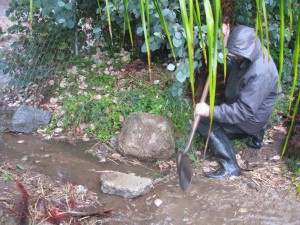
Jacob helping water flow Water flowed under the fence from the street, but instead of flooding a cement culvert as it used to do, it is channeled down to the ponds.
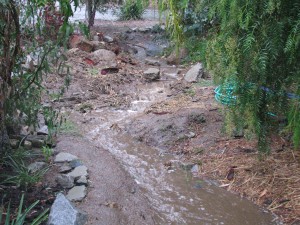
Street run-off enters under the fence 
Blocked by debris, water floods past the bridge Silt and debris blocked water flow under the bridge, and was eroding the area by the structure called the Nest. I cleared the debris and raked rocks and silt to the weak side, and that fixed the problem temporarily.
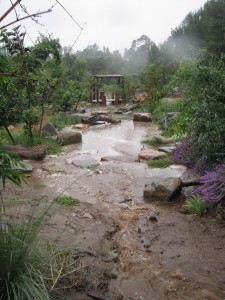
Rainwater flowing into the first 'dry' pond Water quickly filled the first dry pond; with the high clay content, water percolates but does it slowly.
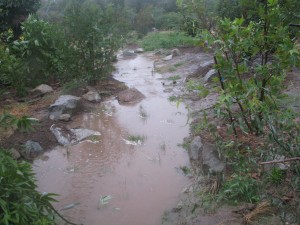
'Dry' ponds filling and slowing run-off 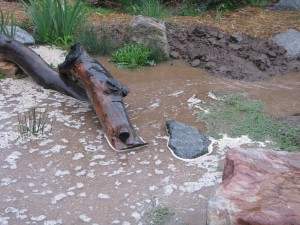
Logs and rocks are ornamental and slow water flow 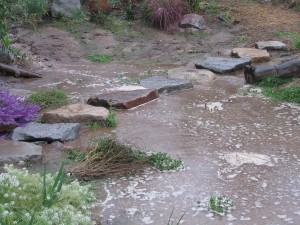
Normally dry, the stone crossing is now almost underwater 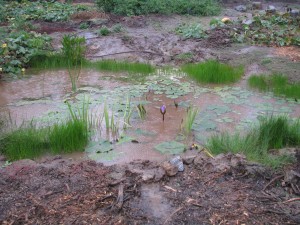
The little pond is rapidly filled. As water reached the small pond, which wasn’t intended to permanently hold water but the clay had a different idea, the sides had to be shored up and the overflow diverted.
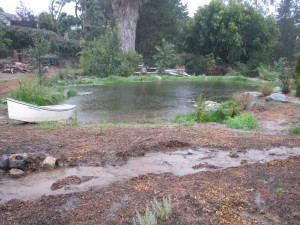
Water is diverted from the little pond around the big one Extra floodwaters aren’t being diverted into the large pond because we don’t want it filled with silt, and we don’t want it overflowing rapidly and eroding the sides. Instead the water flows through a channel around the large pond, then down to a prescribed place to flow out and over the embankment to the stream below.
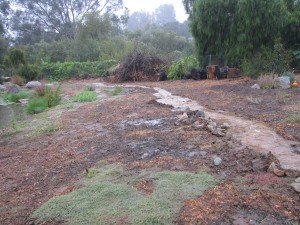
Overflow is channelled past the ponds and out to the natural stream below Some areas of heavy erosion had been filled and supported, and as of six this evening they looked wet but not iffy. What a night of heavy rain will do, I’ll have to see in the morning. I am very lucky to have this type of
rain early in the season. It has been heavy enough to cause significant water flow to help shape the watercourse and show weak spots, and the rain will be reduced to showers tomorrow then clear up, so repairs and improvements can be made before true flooding happens later in the year or early in the next.Although much more water is being held on the property, and topsoil is not being lost, it still pains me to see so much rain channeled out to the stream. Rainwater is a neutral Ph, and carries nitrogen (especially when
there is lightning). It is the best possible water for plants, as well as for human consumption and bathing. In side-by-side comparisons with tap water, plants watered with rainwater flourish far beyond the growth of the others. I’m greedy to hold that water onto my property, letting it soak as deeply as possible for tree roots to use far into the year. As the newly planted trees grow, their roots will help hold water and soil. As their leaves drop the mulch levels will raise, aided by compost and mulch that I will be constantly adding, and the soil will become more absorbent farther down. Each rain should have less runoff and more absorption. This rain has shown a great success with the garden, but I know it is only the beginning. - Chickens, Gardening adventures, Heirloom Plants, Permaculture and Edible Forest Gardening Adventures, Photos, Ponds, Rain Catching, Vegetables, Vegetarian
The August Garden
Plants have been enjoying the beautiful weather and the constant irrigation from the well, and the garden is flourishing. So, unfortunately, is the Bermuda grass, but that is another tale. Since I see it everyday I don’t notice the change so much, but when I show someone around I am thrilled all over again with the incredible change that has happened on this property. There are so many birds, insects, reptiles and other animals either already here or scouting it out that I know the project is a success. It is a habitat, not just for me and my family, but for native flora and fauna as well. It wasn’t so long ago that I had a cracked, weedy asphalt driveway, a termite-ridden rickety porch that needed pest control, a house with a stinky deteriorating carpet and old splotchy paint, a tile kitchen counter with the grout gone in between and a cleaning nightmare, and a yard full of snails, weeds and Washingtonia palm trees, with the embankment eroding each rainfall. Over the last four years we’ve survived some pretty intense construction projects (none of which were done on time, no matter what they promised!). My house still has some repairs that need to be done but I no longer am embarrassed to have anyone over. The garden is wonderful to walk in and explore. I’ve taken some photos this evening to show you how things are growing:
Bees enjoying purple coneflowers The luffa squash has mighty asperations. A luffa squash and bloom. They are edible small and green, but I’ll leave them to dry. Five eggs today! Each laying hen participated for the first time! The little girls have grown up. The small lower pond and the palm pathway. The veggie bed. Rushes, fleabane, waterlilies and other plants are growing in nicely around the big pond. The boat is still on loan from Aquascape. A pumpkin tree? This apricot isn’t healthy, but the pumpkins sure are. These bare areas I’ll fill with plants that will make up guilds, each plant filling a niche to help the others grow. The entrance to the bee garden. Native vinegar weed loves a place we left untouched, and so do the bees. Sugar pumpkins ready a little early for Halloween. A feral zucchini, still producing at least one a day. Melons, passionfruit, pitcher plant and many others under the back porch we call the Poop Deck. Very eager bamboo, sugarcane and hops. Olive trees tied to painted PVC pipe to make a hut. The ‘Nest’ beyond the dry stream bed. A thud and a swish… with no warning the neighbor’s tree fell across the fence. A green roof for the entranceway, just beginning to show. The watermelons in the vegetable beds were tiny… these monsters are wild. That one grew on the rock on its own. Entranceway flower tunnel… with dogs waiting to go inside! -
Well, Well, Well!

A Big Rig The battle for the water looks as if it is slowly being won. Today a 100 foot deep eight inch hole was drilled behind my pond. I feel sorry for the earth, like a big mosquito has stabbed into it’s bedrock.Fain drillers had quite a time maneurvering their truck in backwards. A portion of the fence had to be removed for the ginormous truck to back in. Then it had to move back and forth by inches to get around all the plants and rocks.
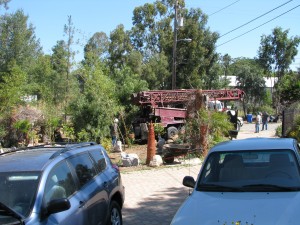
Backing through the fence 
Backing down the property Finally it was in place, and they balanced the truck with lifts so that the back end was off the ground!

Leveling the truck Raising the drill bit was very impressive. It is so tall!

So tall! As they drilled, up came slurry of water, clay, and decomposed granite.

Water and slurry They drilled 100 feet today, and and found water that is moving at about fifteen gallons per minute.

Adding bits For the drip system, I only need a mere five. However, I don’t know what may happen, if I may want to hook the house water up to the well some year or something. If I have them drill more deeply now since thieir truck is in the yard, the well might have a better rate of flow, better water, and possibly a more reliable supply.

Changing parts What I have might be just fine, and there is no guarantee that anything will improve with more drilling. I’ll make my descision over the weekend. On Tuesday they’ll drill some more if I want it, then put in a casing, gravel around the casing, cement the top, and then we can lower the pump and get well water! Cross my fingers!
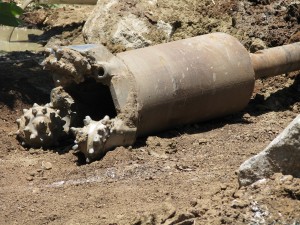
Mean-looking grinding bit

